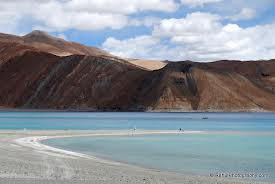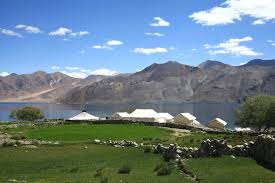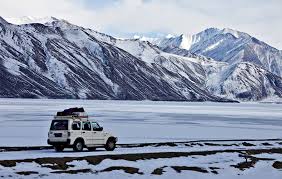|
The Pangong Lake or “lake of the
great hollow” lies about 16 0
km to the north-east of Leh across the chang la pass and is
considered as the largest lake in Asia. The water is clearer
though salty. It is believed that these waters must have been
fresh at some ancient age. The mountain ranges at the pangong’s
north-western extremity are of lime stones which seem to affect
its water. 0
km to the north-east of Leh across the chang la pass and is
considered as the largest lake in Asia. The water is clearer
though salty. It is believed that these waters must have been
fresh at some ancient age. The mountain ranges at the pangong’s
north-western extremity are of lime stones which seem to affect
its water.
The Crystal clear salty water shines
in many shades of blue depending upon its depth. It literally
changes shades with sunlight. With a backdrop of mountains of
various hues and colors, It is a sight for the Gods. At an
elevation of 4300 meter, the air is cool even in summers at Ladakh.
Pangong Lake is about 4 Km wide on the average and at least 136 Km
long. The extent of the known portion is, therefore, upwards of
250 square miles (400 sq km) or about the same size as the holy
lake of Mansarovar.
Only about a fourth of Pangong Lake is in India-till it takes an
easterly turn and disappears into Tibetan territory. Towards the
east, pangong is supposed to have sweet water. With its rare black
necked cranes and other birds, it is the sight beyond one’s
wildest imagination. But sadly Pangong is also ‘sensitive’ with
some of the opposite bank being controlled by the Chinese. The man
and merak village with the backdrop of the snowy peaks of the
pangong range offer a grand view.
The series of lakes goi ng
under the name of pangong extend over 150 km, the longest lake of
the series being 60 km in length and between 3 to 6 km in width.
It is a saltwater lake. The color of the water ethereally
entrancing passes through the various shades of lovely green and
blue as the sun changes its position in the sky or a passing
clouds floats over the lake. ng
under the name of pangong extend over 150 km, the longest lake of
the series being 60 km in length and between 3 to 6 km in width.
It is a saltwater lake. The color of the water ethereally
entrancing passes through the various shades of lovely green and
blue as the sun changes its position in the sky or a passing
clouds floats over the lake.
Near Spangmik Village :
Pangong Lake
The farthest village of pangong area is spangmik located at 6-7 km
along the southern shore up to which the foreign tourists are
permitted. One can have a spectacular view of mountains of the
Chang-Chenmo range to the north west of the Pangong Lake with its
image reflecting in the lake’s ever-changing blue blue and green
water. Above Spangmik are the glaciers and snow-capped peaks of
the Pangong range.
Spangmik Village near Pangong Lake
Besides Pangong, there are some other lakes in the region of which
Hanle Tso is the largest fresh water lake in Ladakh fed by a small
fresh water stream and drained from the lofty range of mountains.
The Hanle monastery is situated to the east of the lake. Tsearh
Tso is 6 km towards north of Pangong Lake at an elevation of 13950
ft adjoining the Merak Tso situated in the village of man at an
elevation of 13900 feet. Tso Rul is another lake situated in
Chushul at a distance of 10 Km towards south of pangong lake. This
lake runs 25 km in length with breadth 2-3 km. it is a bitter
water lake.
The famous Khurnak fort near the international border stands on
the bank of Pangong Lake.
Pangong Lake in winter:
During winters, the Pangong La ke
freezes and the yaks, ponies and goats walk over the frozen hard
surface of the lake when they migrate from place to place. A
number of animals and birds roam around the Pangong Lake which are
protected by the wild life department of the state government.
Spangmik and some other small villages along the pangong’s
southern shore are the summer homes of a scanty population of
changpas. Changpas are the nomadic tribes of Changthang Valley in
Ladakh range. The pangong Changpas cultivate sparse crops of
barley and peas in summer. In winter they go to distant warmer
places. ke
freezes and the yaks, ponies and goats walk over the frozen hard
surface of the lake when they migrate from place to place. A
number of animals and birds roam around the Pangong Lake which are
protected by the wild life department of the state government.
Spangmik and some other small villages along the pangong’s
southern shore are the summer homes of a scanty population of
changpas. Changpas are the nomadic tribes of Changthang Valley in
Ladakh range. The pangong Changpas cultivate sparse crops of
barley and peas in summer. In winter they go to distant warmer
places.
Pangong
Lake lies on the border between Ladakh and Tibet with half the
lake in India and the other half in Tibet. This immense salt water
lake measures 162 km long and 23 km width and is surrounded by
high peaks and passes.
Itinerary
Day 1 Drive from Leh to Pangong Lake via the 5320 m Chang
La with the option to visit the monastery of Chamde en route.
Spend a few hours walking along the lake and return to Leh or
spend the night in the village of Spangmik which sits along the
shores of Pangong Lake. Pangong Lake near Spangmik.
Day 2 (optional)
Sleep at village of Spangmik and watch the sunset and sunrise over
the lake. After a morning to see around the lake return to Leh. |